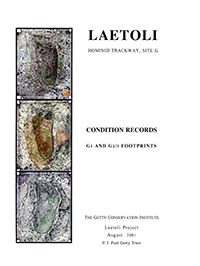Condition Records, G1 and G2/3 Footprints

Getty Conservation Institute
2001
Download PDF Low resolution (38.9MB)
Download PDF High resolution (55.5MB)
The Pliocene site of Laetoli, which preserves both hominid and faunal tracks, has immense scientific value, particularly for understanding human evolution. The trackway at Site G, fortuitously preserved within layers of volcanic tuff, offers unique evidence of bipedalism in hominids from 3.6 million years ago. Excavated by Mary Leakey in 1978-79, the trackway was documented and then reburied underneath a mantle of soil and lava boulders. Soon after, acacia trees and other vegetation took root in the burial fill, raising concerns about the survival of the trackway. In 1993 this concern led to a joint Getty Conservation Institute–Government of Tanzania project to conserve the trackway.
This report is a detailed record of the condition of the trackway's fifty-two hominid footprints and any treatments, such as root extraction, tuff consolidation and re-attachment, that were carried out in 1995 and 1996 as part of the conservation program of the Hominid Trackway at Laetoli project. The report includes a description of the methodology followed, a glossary of terms, a graphic record overlaid on photographs, a photogrammetric contour map at 1mm intervals, and text description of both conditions and treatments for each of the footprints.
How to Cite this Work
Getty Conservation Institute. 2001. Laetoli Hominid Trackway, Site G: Condition Records, G1 and G2/3 Footprints. Los Angeles: Getty Conservation Institute. http://hdl.handle.net/10020/gci_pubs/laetoli_condition_records
|
||||||||||||||||||||||||||||||||||||||||||||||